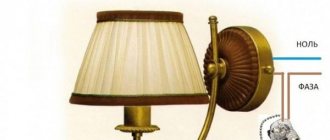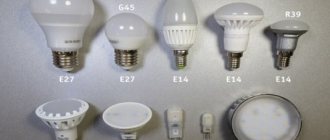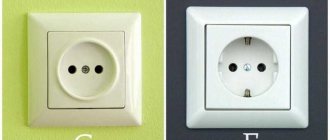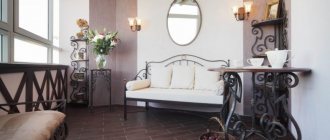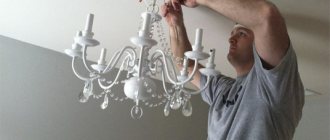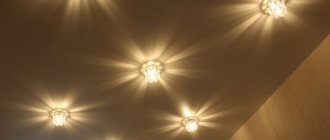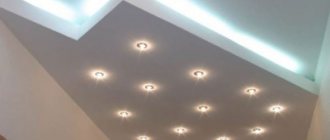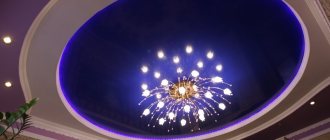How to choose the right lamps for a suspended ceiling
Stretch ceilings are a canvas mounted on a baguette. The material has low heat resistance. Therefore, if high-power ceiling light bulbs are used, the fabric may turn yellow and crack.
Circular arrangement
Often such ceilings are equipped with LED or halogen light bulbs. Sometimes fluorescent energy-saving light sources are installed.
By light bulb power
LED light bulbs have a high degree of light output compared to incandescent or fluorescent light sources. They begin to shine brightly immediately when turned on. Luminescent ones light up within half a minute.
Various types of lamps
Several lighting elements are often installed in fabric ceilings; the power of one light bulb should not exceed 40 W. Rotating lights may be a little more powerful.
Halogen ceiling light
Halogen lamps are incandescent lamps. They are available in different types according to base, size, and appearance. Iodine or bromine vapors are added to the cylinders.
Chandelier
These types of ceiling lighting equipment do not burn out in the event of voltage surges, have a long service life, and are highly durable. Due to its special properties, only lamps with a power of up to 20 W can be used as lighting fixtures on a fabric ceiling.
Advantages of spotlights
One of the main advantages of spot lighting is its versatility. With its help you can not only illuminate the entire space of the room. Such options are also used for zoning premises to highlight a work area or a recreation area. In this case, more powerful lamps are installed above a certain place in the room or, conversely, characterized by soft diffused light. Using several small light bulbs distributed throughout the ceiling area, instead of one standard chandelier, will allow you to save on electricity. It is not necessary to use incandescent lamps. Diode, halogen or fluorescent lamps consume much less electricity, but illuminate the room no worse.
Read also: Gas cylinder capacity 50 liters per m3
Unusually wide scope for creative thought. You will find an incredible number of models that will help make your home stylish and cozy. Such lamps are practically insensitive to voltage changes. They will work even at minimum power. They can be used anywhere. These can be living rooms, hallways, kitchens, bedrooms, children's rooms, bathrooms, swimming pools and even office spaces. In any case, the ceiling will look great and the room will receive enough light.
What parameters need to be taken into account during installation
To illuminate a room well, you need to know how to place lamps on a suspended ceiling. It is important to consider the distance between pieces of equipment. The requirements for lamp placement are as follows:
- point devices should be located at a distance of at least 20 cm from the wall;
- a chandelier in a room clearly divided into rooms should be located exactly in the middle; if we are talking about a studio, the center for the main lighting fixture is determined for each zone separately;
- taking into account the seams on the PVC sheet that connect the parts of the film, it is necessary to install lighting devices at a distance of 15 cm from the joints;
- It is important to consider that one piece of lighting equipment illuminates a room with an area of one and a half to two meters. For example, for a twenty-meter room you need to install ten or more light bulbs;
- when determining a symmetrical option for placing lamps on the ceiling, the devices must be installed at an equal distance from each wall and between each other;
- from the fabric ceiling to the light sources, spotlights are located at a distance of two centimeters, and a chandelier - one and a half centimeters;
- If you do not hang a chandelier in a large room, dark areas may form. To prevent this, devices should be installed outdoors. In a room divided into zones, it is best to use rotating light elements.
You might be interested in this: What is a floodlight with a motion sensor and how to use it
Rotating light
Please note! By following some basic rules, you can easily create enough lighting for every room in your apartment that has a ceiling, without damaging the fabric. There are no restrictions or distance requirements regarding windows.
Installation of lighting fixtures in different rooms
The location of lamps in the kitchen determines the need to take into account the surface area of the ceiling and its shape. In standard apartments, there is no dining room as a separate room, so it is necessary to zoning the room: a cooking area and a dining area.
For small rooms, it is enough to install spotlights. For large rooms it is necessary to select a chandelier and a group of light bulbs. To achieve maximum effect, lighting devices are placed in three rows. This avoids the appearance of shadows on areas of the ceiling.
If the ceilings in the kitchen are low, it is better not to choose a large chandelier or simple fixed lamps. It is better to place devices in a zigzag. This option will help illuminate key areas of the room.
In the kitchen, you can install both ceiling spotlights and appliances above the countertop, fixing them on cabinets.
Zoning the room with lamps
It is impossible to place a large number of appliances in the bathroom due to the small area of the room. The effect of diffused light is achieved using tiles, a large number of mirror-type surfaces, and chrome parts. If you use a standard arrangement of lighting fixtures, four to eight elements are sufficient.
Note! It is better to purchase waterproof round lamps for the bathroom. Devices can be placed in the shape of a square, diamond, or diagonally. This allows you to create an original design option.
The living room is the main room in the house. Therefore, it should be bright, memorable, unusual. Decorating a room often takes the most time, as it needs to be illuminated as much as possible.
A chandelier is placed in the central part (if the ceiling allows). Auxiliary spotlights for illumination are placed around the perimeter of the room. In this case, you can create dim light in certain areas of the room.
You might be interested in: Features of street lighting
The choice of element placement is not limited to standard options. The large chandelier in the middle with lamps in all corners on the square ceiling looks interesting.
Wave location
If you don’t need bright light in the room, you can use a chandelier in the center. Then the devices should be placed on the surface as evenly as possible. You can also zone the room by making different lighting in parts of the room. If there is a large TV in the room, this part of the room needs to be darkened a little.
Bathroom lighting
Spotlights that are mounted into the structure are great for the bathroom. The distance between the lamps should be the same. To illuminate a small bathroom, 4-6 spot lamps are enough.
When choosing, it is worth considering that the bathroom is humid and damp, so you need to select devices that are not afraid of moisture.
Popular layouts
There are two options for placing spotlights on a suspended ceiling: combined and classic.
The combined system involves placing point-type equipment together with the main element - a chandelier. This device provides basic artificial light in a room. Additional elements serve a different function, adding background in the corners and edges of the room. Separated devices will provide a comfortable level of lighting.
Light bulbs in the kitchen
The classic installation option is used when using medium-power point devices. They help to realize different design ideas and intricate patterns. The advantage of this scheme is the ease of replacing damaged elements.
There are several universal layouts for spotlights with a chandelier on a suspended ceiling. Each of them includes placing a chandelier in the center of the room:
- corner Additional lamps are located in the corners of the room;
- one-sided. Spot devices are installed only on one wall. One bright chandelier can be installed in the center or three at a not too equal distance from each other along the midline of the room ceiling;
- straight. Light bulbs are placed along opposite walls;
- corner triangular. Lamps are placed in a triangle at the corners of the room, creating enhanced lighting for these areas;
- semicircle. Lamps are placed in a rectangular or elongated room in a semicircle, allowing you to illuminate the entire room;
- oval. In this scheme, the devices are installed in the form of two semicircles, which together form an oval;
You may be interested in How to properly connect a fluorescent lamp
Bathroom lights
- rectangle. The option allows you to expand the room by installing equipment along all walls in the canvas itself on one level and in the gypsum base on the second level;
- wave. This option for placing devices is suitable for rooms with a non-standard layout. Can be used on single-level or multi-level ceilings;
- one-sided corner. The scheme provides for the placement of lighting equipment along adjacent walls. Helps to highlight an area in a large room;
- circle. Additional lamps are installed in a circle at some distance from the chandelier;
- cross. The scheme involves installing lamps crosswise. In this case, the central chandelier does not need to be attached.
Layout diagrams
A fabric stretch ceiling allows you to place lighting fixtures in any way you like. The main thing is to follow the installation rules and calculate the distance between the elements with each other and the ceiling.
Basic installation rules
Standard suspended ceilings with built-in lamps are increasingly conquering the construction market. However, if you want to make lighting according to an individual sketch, you need to adhere to the following algorithm:
- Everything starts with developing a sketch. You must correctly calculate how many lamps you will need, what kind of light bulbs will be used, as well as what pattern will emphasize and express the style of the room and fit perfectly into the interior.
- After the calculations, mark the ceiling.
- The next stage is correctly made holes in the canvas.
- Lay the electrical wiring to the place where the lamps are connected. The power cable can be hidden in an inconspicuous-looking corrugated sleeve. This way you will have all the wires in one bundle, there will be no confusion when connecting, and the wiring will have a neat and aesthetic appearance.
- Lighting fixtures are installed in holes in the canvas.
- Next comes the direct connection of the luminaires to the power supply network.
